Tools for social media monitoring are the best way to find out what people are saying about your brand. And also what they’re saying about your product, your competitors, your industry, your Super Bowl ad, your pandemic response, your customer service wait times, your new mascot — basically, anything your audience could possibly have an opinion on.
In other words: social media monitoring software gathers and presents audience and competitive insights for brands who want to pay attention.
In this post, we’re going to look at some of the best social media tracking tools on the market, and go through set-up and best practices so you can start tapping into the conversation today.

What is social media monitoring?
Social media monitoring means tracking hashtags, keywords, and mentions relevant to your brand in order to stay informed about your audience and industry.
By monitoring social media data, you’re doing research that is both quantitative (metrics and analytics) and qualitative (inspiration for posts and strategies). You’ll get information that can help you determine things like:
- Social share of voice (i.e. what percentage of the conversation is about you, as opposed to being about your competitors)
- Social sentiment analysis (i.e., what’s the mood of the conversation)
- Social ROI (i.e., how much your dollar investment in social is paying off)
- Relevant hashtags and keywords (i.e., which Instagram hashtags or YouTube keywords you might want to use in the future to expand your reach)
- Trends (i.e., what is your audience talking about, what new ideas, aesthetics or memes are popping up, are the platforms offering new tools and services, etc.)
For brands, social monitoring is an essential part of being a good social citizen, making more informed decisions, and succeeding on social, period.
For instance, you wouldn’t launch into a high-pressure sales pitch (or informative lecture, or even a stand up routine) to a new customer who’s just walked in the door. You’d listen first, and at least figure out what they’re looking for or why they’re in your office. Social media monitoring platforms help you do just that.

Likewise, on social media, paying attention to what people are saying is necessary to be relevant, engaging, and to prevent yourself from making off-key blunders.
Get you some customers who love you as much as Johnsonville Sausage’s customers love them.
Note: You’ve probably also heard of social media listening, which is the next step you’ll want to take after social media monitoring. Social listening involves not just gathering and analyzing the metrics, but taking action. Read our article about social media listening tools over here.

If you want to learn more, check out our overview of how we do social media monitoring (and listening!) here at Hootsuite:
Bonus: Download a free guide to learn how to use social media monitoring to boost sales and conversions today. No tricks or boring tips—just simple, easy-to-follow instructions that really work.
7 brand social media monitoring tools
For brands and businesses, social media monitoring goes beyond just typing your own name into the search bar on Instagram or Twitter. This is why we’ve compiled this list of the best brand monitoring tools for making the task faster, easier, and—dare we say it—more fun? (Ok, ok, you don’t have to give me that look.)
1. Hootsuite
What does it monitor? All major social media platforms
Paid or free: Plans start at $99/month for up to 10 profiles. Try Hootsuite with an unlimited 30-day free trial.
Arguably the easiest social monitoring tool to use on this list, Hootsuite’s customizable search streams will monitor any social platform you like so that you can see what’s going on at a glance.
Zero in on essential topics, track social media trends, and monitor mentions based on keywords, hashtags, locations, and specific users.

If you really want to dive deep on social listening, you can also try Hootsuite Insights.
This paid tool is powerful enough to qualify more as a social listening tool than a social monitoring app, but Hootsuite Insights can give you an instant overview of millions of online conversations in real time.
Search for any topic or keyword, and filter by date, demographics, location, and more. You’ll be able to identify thought leaders or brand advocates, understand the perception of your brand in the market, and get immediate alerts if and when your mentions spike (for good or for bad.)
Hootsuite Insights can tell you a lot about your target audience — and how they feel about you. It’s only available to enterprise users, but if you’re serious about social listening, Insights is the only tool you’ll need.
2. Talkwalker
What does it monitor? Most major social platforms + broader web
Paid or free? Paid tool
Talkwalker offers more than 50 filters to monitor conversations across 150 million data sources, including blogs, forums, videos, news sites, review sites, and social networks.
You can use Talkwalker to analyze engagement, reach, comments, brand sentiment, important influencers, conversation clusters, and much more.
Talkwalker is especially useful to spot activity peaks in conversations about your brand. This can help you determine the best times for your brand to post on social media.
Bonus: Watch our AMA with Talkwalker here to learn more.
 Source: Talkwalker
Source: Talkwalker
Psst: Hootsuite is set to acquire Talkwaker VERY SOON. This means that you will get access to Talkwalker social listening and analytics directly in your Hootsuite dashboard!

3. Nexalogy
What does it monitor? Most major platforms + broader web
Paid or free? Free tool
Nexalogy’s top-tier data visualizations set it apart: interactive timelines, geolocation-based heat maps, lexical cluster maps that show common patterns of topic. Plus the “basic” stuff that would take a human being weeks to figure out, like popular keywords and most active accounts.
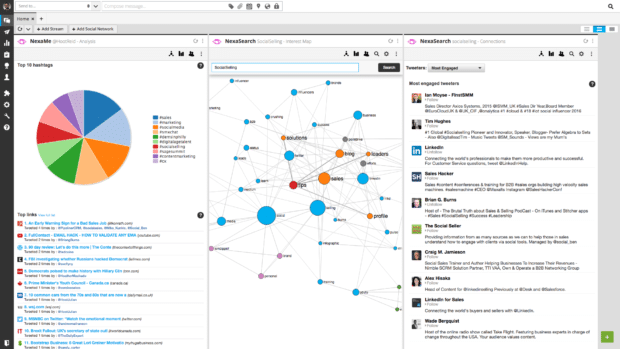
4. Mentionlytics
What does it monitor? All social platforms + broader web
Paid or free? Free tool
Mentionlytics is a professional-grade social media monitoring app that tracks mentions, keywords, and sentiment across multiple languages.
5. Reputology
What does it monitor? Yelp, Google, Facebook reviews + other review sites
Paid or free? Free tool
For customer-facing businesses, a bad review can be a real blow if it isn’t dealt with correctly and quickly. Reputology lets you monitor major review sites such as Yelp, Google, and Facebook reviews from one dashboard.
You can track activity across multiple storefronts and locations, and respond using quick links.
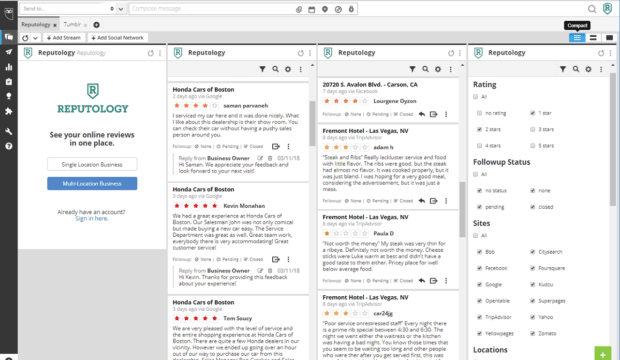
6. Tweepsmap
What does it monitor? Twitter
Paid or free? Free tool
This combination analytics/social monitoring tool is built to show Twitter power-users how hashtags and topics travel, so you can tune into what your audience is talking about.
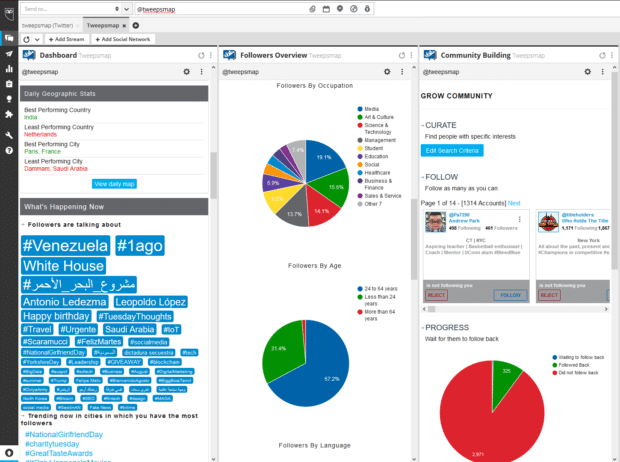
7. Reddit Keyword Monitor Pro
What does it monitor? Reddit
Paid or free? Paid tool
With 430 million average monthly active users, Reddit is an often-overlooked social platform where conversation is often in-depth and honest. This tool allows you to monitor the site’s 138,000 active communities for the conversations you care about.


How to set up social media monitoring
Step 1: Choose the best social media monitoring tool for your purposes.
Refer back to that list above, if you haven’t narrowed it down yet.
Step 2: Brainstorm your search terms.
What words or names do people use when they talk about your brand?
If you’re a fast food chain, people might mention your veggie burgers a lot more than they mention your CEO. Whereas if you’re a 5-person AI startup, the name of that famous investor might be the entry point for discovery. Here are some places to start:
- Brand or company name as both handle and mention (i.e., @MoodyBlooms and #MoodyBlooms)
- Product name(s) (i.e., #PeekFreans #MoonPie)
- Names of thought leaders, CEOs, spokespeople, etc.
- Slogans or catchphrases
- Branded hashtags (i.e., #optoutside, #playinside, etc.)
You’ll also want to repeat all of the above for each of your major competitors.
Next, expand your sightlines to include your industry, vertical or niche.
- Industry hashtags or keywords (i.e., #inboundmarketing, #SEO,)
- Community or group hashtags or keywords (i.e., #banffcentreartist)
- Platform-specific hashtags or keywords (i.e., #containergardenersofinstagram, YouTubers)
- Location hashtags or keywords (i.e., #MileEnd, #JasperNationalPark #QueenWestWest)
For a detailed rundown on the most common search monitoring queries brands are running, watch our recent webinar with Brandwatch.
Step 3: Set up your searches in your brand monitoring software.
This will depend on which tool for social media you choose. In our humble opinion, the more simultaneous and saved searches a tool offers, the better. (Typing your chief rival’s name into the Instagram search bar every day is just too depressing.)
Here’s a quick how-to video that goes over how to use Hootsuite’s stream feature, in case you’re curious about how it works:
Step 4: Check your streams regularly.
If you’re the brains and the thumbs behind the company Instagram, you’ll be checking your streams daily, or even hourly, or perhaps you’ll never really not be checking them.
On the other hand, if shaking hands and kissing babies on social is not in your job description (because cutting bouquets or training horses is), then set a reminder for yourself to browse your search findings.
Trust us, you’ll thank us later.
Step 5: Remember to revisit your search terms and adjust accordingly every so often.
Like all jobs that involve social media, social monitoring is never really done. After you’ve set yourself up and monitored for a few weeks, take another look to see whether your search is really catching everything you want, while filtering out what you don’t.
If you’re getting too many results, especially unrelated ones, consider tightening your search parameters. If you’re not seeing much pop up, then widen them. (Tip #2 in this article on research explains how to use Boolean operators to your advantage.)
Social media monitoring tips
Monitor in all the languages your customers speak.
This one can be easy to overlook for North Americans used to working in one language. But if your company just acquired a start-up in Montreal, remember to set up searches using French, English (and Franglais??) words and phrases.
Meanwhile, if your new client does a lot of work in a language that you don’t speak, work with the local team to find out how to spell “love it” in Vietnamese, or “the worst” in Russian.
Depending on the size and relative importance of your audience, you might want to use a language-specific social monitoring tool. Crowd Analyzer, for instance, excels at social monitoring in Arabic.
Many social media monitoring services (ahem, Hootsuite) allow you to share permissions with team members so that you can get help where you need it, like for instance from your French or Spanish colleagues.
Feed your hashtag and keyword strategy while you’re monitoring.
If you’ve ever been stumped by what hashtag to add to an Instagram post, or paused in horror as you consider what will happen to your views if you don’t find the right keyword for your YouTube video, social monitoring can help.
For instance, listening features like the word cloud in Hootsuite Insights will provide ideas as to which keywords or hashtags you might want to add to your ongoing monitoring activities.
But it can also provide keywords and hashtags that you’ll want to use on your own posts as part of your overall hashtag strategy.
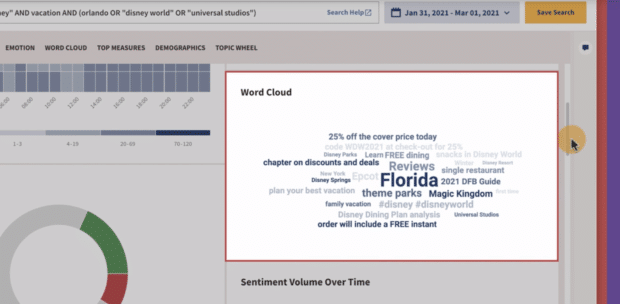 Source: Hootsuite Insights
Source: Hootsuite Insights
Know the language your followers are speaking (i.e., are people talking about “container gardening” or “balcony plants”?) so you can help them find your amazing content.
Identify influencers and brand advocates you might want to partner with.
Another smart way to level-up your social monitoring is to keep an eye out for the repeat offenders. As you babysit the endless scroll, pay attention to people who repeatedly engage with or mention your brand.
If they’re always applauding or cheerleading, and have a following of their own, you might consider including them as part of your influencer marketing strategy.
Choosing a tool that can do the complicated math to figure out who your biggest fans are is an easy win.
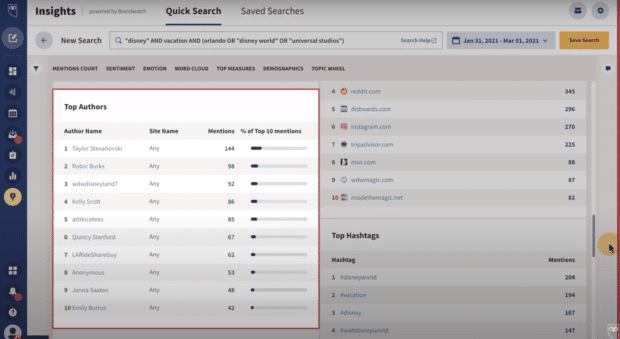
Source: Hootsuite Insights
Set alerts for unusual activity.
If your sentiment takes a nose-dive when your new TV ad rolls out, or your competitor launches a terrifyingly cool new product, the social team should be among the first to know about it. Social media monitoring tools are essential for brand reputation management.
A social media crisis (or just a regular PR crisis) can arise at any time. Social media monitoring can alert you if mention volume surges, or the social sentiment meters are ticking over to red all the way down the board.
The correct tool will not just warn you, but make sure you have real-time insights at hand to help make decisions about how to solve the problem.
Share your results.
Speaking of sharing: let the rest of your team (or company) know what you’re seeing.
Sometimes, social media managers—humble people that we are—forget that we have an unparalleled view into customer sentiment and our organization’s reputation and status in the world.
How much do you want to bet that your sales team, let alone your CEO, have the time, know-how, or tools to sift through the Niagara Falls of opinions and feelings that the world’s 4.5 billion social media users are sharing online?
Social media monitoring reports are important for two reasons:
- Proving your work is worth 24% of the marketing budget (I’m not pointing fingers, but sometimes people need to be reminded) and,
- Making sure your insights about your customers and potential customers are getting to the people who are making decisions.
So, whether your company is customer-obsessed or data-led, our advice is to choose a tool that easily integrates social media monitoring with custom reporting.
Use Hootsuite to easily find and monitor conversations that are relevant to your business on social media. Save a ton of time and improve performance with an all-in-one social media management tool. Start your free trial today.
The post 7 Top Social Media Monitoring Tools and Why You Need Them appeared first on Social Media Marketing & Management Dashboard.

